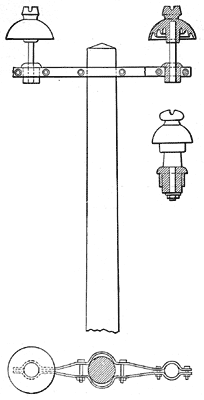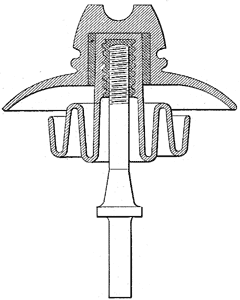[Trade Journal]
Publication: Electrical World and Engineer
New York, NY, United States
vol. 42, no. 2, p. 79, col. 1-2
High Tension Cross-Arm and Insulator.
In Fig. 1 is shown a type of pole cross arm which the well-known French firm, E. H. Cadiot & Cie. have applied to several important transmission lines. It will be seen that the cross are is of metal-iron or steel, and that the insulator pin is secured in a sleeve which latter is then clamped into the end of the arm. The advantages claimed for this system is ease in mounting and in replacing a broken or defective insulator, the additional insulation secured by the use of the sleeve as compared with the usual metal cross arm system, and the less area of contact with the pole, and the greater structural strength of the arrangement. Among the recent installations of this type of cross arm is that on the lines of the 15,000-volt Fuilla transmission plant in the south of France (Pyrenees Orientales).
 |
| Fig. 1. — Pole Cross Arm. |
Fig. 2 illustrates a type of high-tension insulator which has been applied by the same firm to a number of transmission lines, and known as the "Cloche Mehun" insulator. In some tests the leakage at 38,500 volts was only .4 milliampere per insulator. When submitted for 30 minutes to a voltage increasing progressively from 6,500 to 40,500 volts at a frequency of 42 periods, the insulator being plunged in acidulated water, only one broke of a large number submitted to the test.
 |
| Fig. 2. — High-Tension Insulator. |
